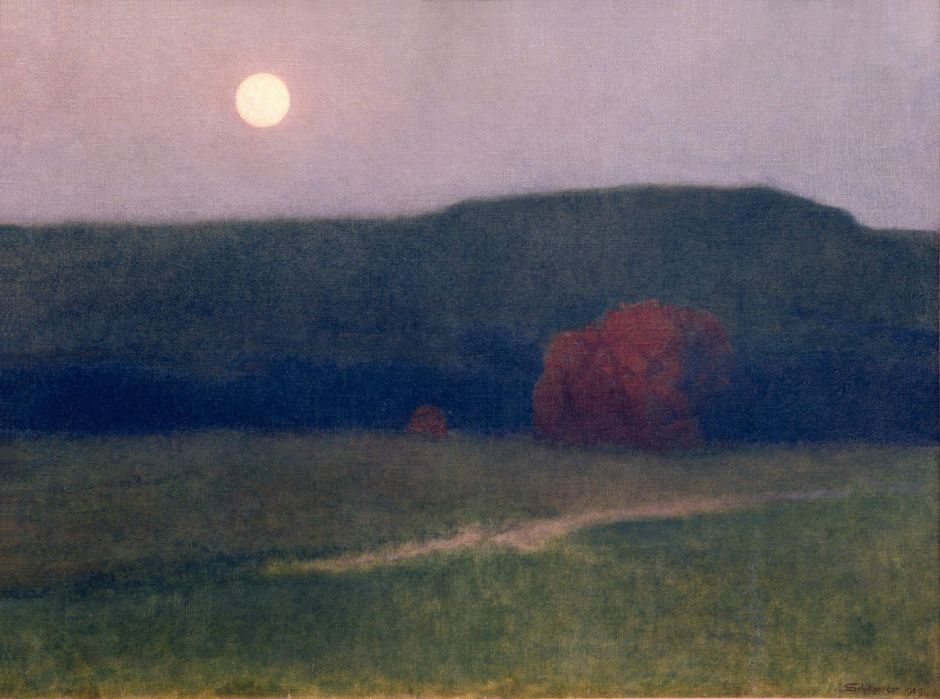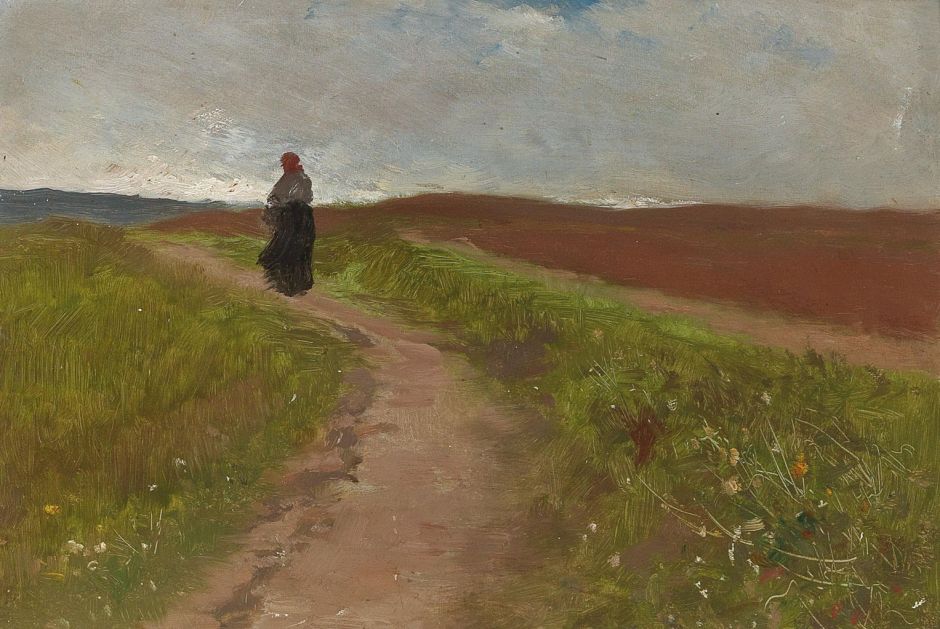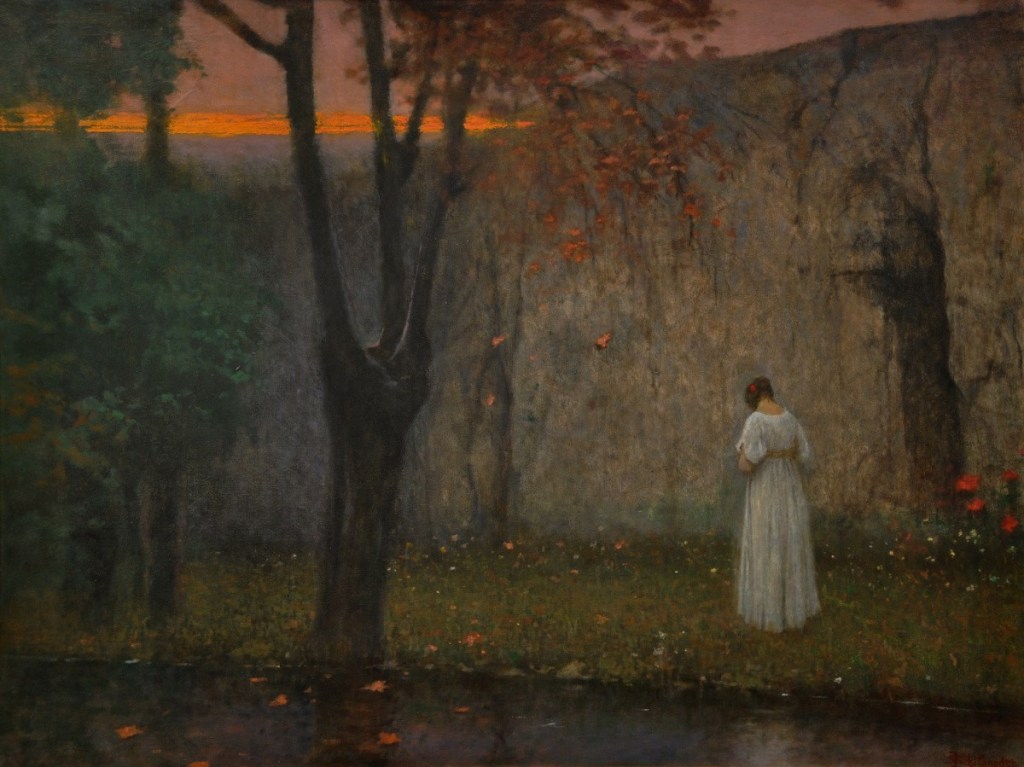This article looks at the later half of the career and paintings of the Czech artist Jakub Schikaneder (1855–1924), the first article of which appeared yesterday. During his earlier years, he seems to have painted predominantly in oils, but after 1900 worked in pastels increasingly frequently.
Schikaneder was involved in the exhibitions of the Prague School of Decorative Arts at the Paris World Fair in 1900, and that in St Louis, Missouri, four years later. He and his wife seem to have visited the coast of the Adriatic and Heligoland, a small archipelago in the eastern North Sea.

Schikaneder’s painting of Evening Street (1906), which I presume shows Prague in the winter, is also quite well-known, and is almost canonical in its completeness.

Evening in the Garden (1907-09) is the first of a pair of paintings in which the same woman appears at dusk, wearing the same white dress, with her back to the viewer. Here she stands in an avenue of small trees which leads to the gate of a house. A full moon has already risen over the roof of the house. Although all appears quiet, there is a sorrow too, and the suspicion that things are not right – the unease conveyed so well in the much later paintings of Paul Delvaux (1897-1994).

Although I was unable to come up with a translation of the title of Staropražská zákoutí (1907-09), the title of this winter night-time street scene apparently means Nooks of Old Prague (thanks to Caspar for that). A carriage stands waiting outside the front of what may be a small hotel, as two women make their way past. Snow is falling.

In Dimming (1909), Schikaneder takes this soft atmospheric approach out into the country, to capture dusk there, with the full moon hanging over a wooded ridge in the early autumn.

By the Girl’s Bed (1909-10) is his interpretation of the theme of childhood illness. As with Christian Krohg, in this case the girl may be chronically ill with tuberculosis, and her mother has come up to check on her as she sleeps by a nightlight. The girl’s bed is arranged so that her body rests almost upright, a characteristic of those with chronic chest complaints such as tuberculosis.

Autumn Red (1910) returns to the lonely figure seen in Evening in the Garden above. She appears again at dusk, with a fiery orange slash through the sky. It is autumn, with the leaves starting to turn copper-brown and falling onto the water behind her. She stands on a narrow grassy strip between that water and a high wall, which still bears the marks of old climbers. Dotted around her are small white and large red flowers.

In the evening in Hradčany (1909-13) shows a spectacular winter dusk in this district of the city of Prague. In the distance are the twin spires and tower of St Vitus’ Cathedral, suggesting this view is on the Čechův Bridge over the Vitava River. A lone woman leans over the wall of the bridge, looking down at the river below. Is she contemplating jumping?
After 1910, Schikaneder became more withdrawn, although he continued to teach until after the First World War.

On Honeymoon (1919-20) shows a couple, again with their backs to the viewer, walking along a promenade by the sea. Schikaneder may have painted this in Heligoland.

Schikaneder’s The Mole (1922-23) may also have been painted when he was on holiday in Heligoland. It shows a small fishing wharf by the sea, in the calm of an evening. As a fishing boat approaches from the left, a group of four people ready themselves outside a hut at the right. They may be waiting to land the catch, and two of them are women wearing white caps.

Schikaneder’s undated Riverbank with Tram shows a tram travelling, most probably in Prague, during a damp and foggy autumn evening.

Dark Path is an undated oil sketch which has been attributed to Schikaneder. He might have painted this during his early career.

Like many artists of this period, Schikaneder displayed a somewhat irreverent attitude to death, as shown in his undated The Last Journey. The Grim Reaper (death) clad in red here accompanies a new recruit to the underworld or afterlife, as they walk together surrounded by large black crows. One of the birds appears to have met its own bloody end just in front of them.
Schikaneder died in Prague in 1924.

